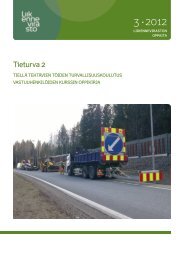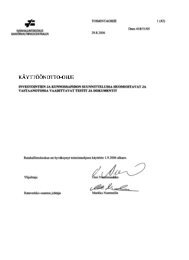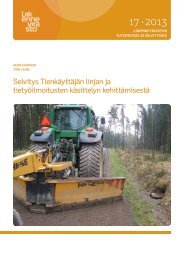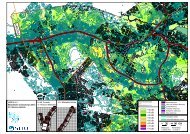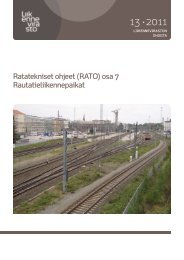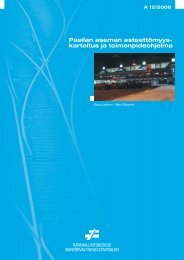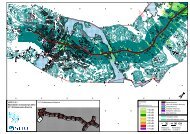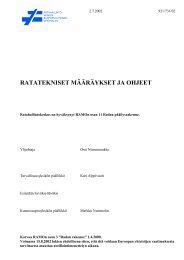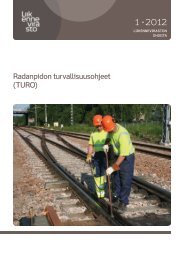Deformation behaviour of railway embankment ... - Liikennevirasto
Deformation behaviour of railway embankment ... - Liikennevirasto
Deformation behaviour of railway embankment ... - Liikennevirasto
Create successful ePaper yourself
Turn your PDF publications into a flip-book with our unique Google optimized e-Paper software.
95<br />
may conflict with the desire to provide a more deformation-resistant mixture by<br />
increasing the fines to promote better packing.<br />
−<br />
−<br />
−<br />
−<br />
−<br />
The effect <strong>of</strong> stress history on permanent strain development has been recognized<br />
in the literature but hardly investigated. The study by Brown and Hyde (1975)<br />
clearly shows that permanent strain is reduced notably as the result <strong>of</strong> stress<br />
history. However, if previous loading has loosened the material (e.g. by dilating it),<br />
the effect <strong>of</strong> stress history is the opposite. In laboratory permanent strain tests, the<br />
effect <strong>of</strong> stress history is eliminated by using a new specimen for each set <strong>of</strong><br />
stresses applied.<br />
Density, described by the degree <strong>of</strong> compaction, is believed to have a pronounced<br />
impact on the long-term <strong>behaviour</strong> <strong>of</strong> granular materials (Thom and Brown 1988,<br />
Barksdale 1991). Resistance to permanent strain in these materials is highly<br />
improved as the result <strong>of</strong> increased density.<br />
The effect <strong>of</strong> fines content on the permanent deformation <strong>behaviour</strong> <strong>of</strong> unbound<br />
granular materials was investigated by Barksdale (1972), Thom and Brown<br />
(1988), and Barksdale (1991), who concluded that the permanent deformation<br />
resistance <strong>of</strong> granular materials is reduced as the amount <strong>of</strong> fines increases.<br />
The effect <strong>of</strong> particle size distribution, or grading, is a disputed subject and<br />
different views are found in the literature.<br />
As for the effect <strong>of</strong> aggregate type, it has been suggested that crushed, angular<br />
materials undergo smaller permanent deformations compared to materials such as<br />
gravel with rounded grains (Barksdale and Itani 1989).<br />
6.2 Stress level<br />
The literature available shows that the stress level is one <strong>of</strong> the most important factors<br />
affecting the development <strong>of</strong> permanent deformations in unbound granular materials.<br />
The magnitude <strong>of</strong> the permanent deformations developed strongly depends on the stress<br />
level and increases with rising deviator stress and decreasing confining stress<br />
(Werkmeister 2003).<br />
Early repeated load triaxial tests reported by Morgan (1966) clearly showed that the<br />
accumulation <strong>of</strong> axial permanent strains is directly related to the deviator stress and<br />
inversely related to the confining pressure. Morgan studied the <strong>behaviour</strong> <strong>of</strong> sands under<br />
repeated loading with an increasing number <strong>of</strong> load cycles and considered the influence<br />
<strong>of</strong> deviator stress and confining pressure on the accumulation <strong>of</strong> permanent axial strain.<br />
He found a direct dependency between the accumulated permanent axial strain after any<br />
given number <strong>of</strong> load cycles and the deviator stress at a particular level <strong>of</strong> confining<br />
pressure. On the other hand, by maintaining the deviator stress at a constant level,<br />
Morgan found that the permanent axial strain was inversely proportional to the<br />
confining pressure.<br />
Barksdale (1972) comprehensively studied the <strong>behaviour</strong> <strong>of</strong> several unbound granular<br />
materials using repeated load triaxial tests with constant confining pressure and 10 5 load




